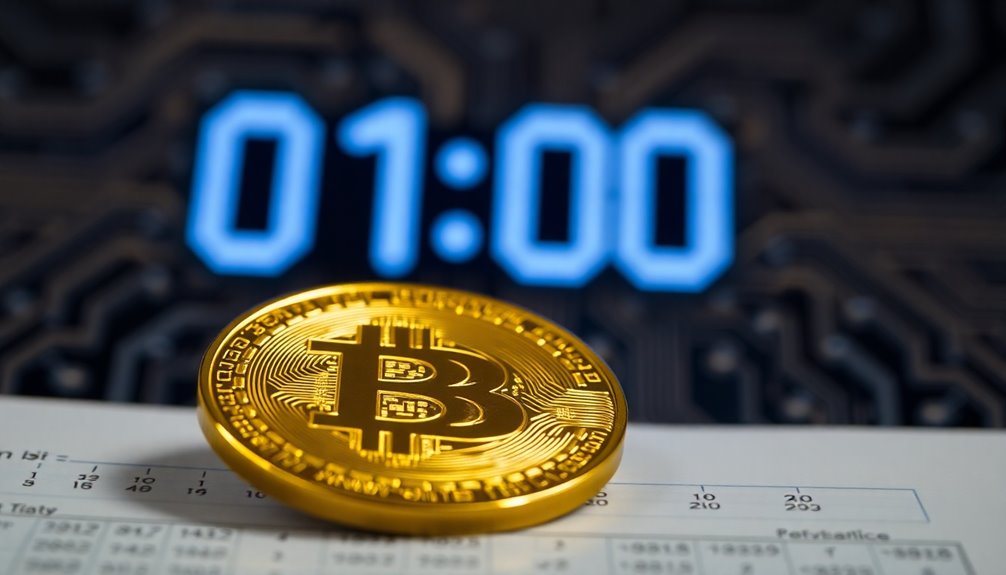Imagine the moment a treasure chest is suddenly locked, its contents dwindling with each passing day. That's what crypto halving does for Bitcoin, cutting miner rewards in half and tightening the supply of new coins. This mechanism creates an air of scarcity, influencing the market dynamics in ways you might not expect. What happens to value when demand stays strong, but the supply starts to dwindle?
Key Takeaways
- Crypto halving is a scheduled event that reduces Bitcoin miners' rewards by half, occurring approximately every four years.
- The halving mechanism ensures Bitcoin's scarcity by limiting the total supply to 21 million coins.
- Scarcity enhances Bitcoin's appeal as a store of value and a hedge against inflation.
- Post-halving, miners' earnings decrease, leading to greater reliance on transaction fees for income.
- Historically, Bitcoin's price tends to increase after halving events due to supply-demand dynamics.

Crypto halving is a crucial event in the world of cryptocurrency, particularly Bitcoin, as it directly impacts the supply and value of the digital asset. This event occurs roughly every four years, specifically every 210,000 blocks mined. When a halving happens, the reward that miners receive for adding new blocks to the blockchain is cut in half. For instance, after the first halving in 2012, the reward dropped from 50 to 25 bitcoins. As of the last halving in May 2020, the reward decreased from 12.5 to 6.25 bitcoins, and the next halving is anticipated between April 16th and 22nd, 2024. The mining reward will decrease to 3.125 bitcoins per block after the next halving.
The halving mechanism is vital for maintaining Bitcoin's scarcity. Unlike fiat currencies, which governments can print at will, Bitcoin has a finite supply capped at 21 million coins. This limited availability helps establish Bitcoin as a store of value akin to digital gold. Because the block rewards keep halving, Bitcoin's supply diminishes over time, which makes it inflation-resistant. This scarcity principle plays a significant role in making Bitcoin a credible alternative to traditional currencies.
When you consider how it works, the halving has profound effects on miners and the overall market. As rewards shrink, miners earn less from block subsidies. This leads to a greater reliance on transaction fees for their income. Consequently, post-halving, the cost to mine a single bitcoin generally rises, potentially leading to a decline in the network hashrate if miners can't cover their expenses. As a result, you might notice fluctuations in transaction speeds and network security.
The halving's impact on price dynamics is particularly noteworthy. With a reduced flow of new bitcoins entering circulation, you could see an imbalance between supply and demand, which might push prices higher if demand remains stable or increases. Historically, Bitcoin's price tends to rise following halving events, although this isn't guaranteed. The correlation between halving and price spikes is closely watched by investors, making the event a significant milestone in the cryptocurrency calendar.
As Bitcoin approaches its final supply limit around the year 2140, the importance of each halving event becomes even more pronounced. Each reduction in supply not only reinforces Bitcoin's scarcity but also heightens its appeal as a long-term investment. The changes in miner rewards and the potential for price increases create a dynamic environment that keeps both new and seasoned investors on their toes.
The halving isn't just a technical event; it's a critical mechanism that shapes Bitcoin's future, helping to establish its role as a major player in the financial ecosystem.
Frequently Asked Questions
How Does Crypto Halving Affect Bitcoin's Price in the Long Term?
Crypto halving affects Bitcoin’s price in the long term by reducing the supply of new coins entering the market, creating scarcity. This scarcity can lead to increased demand, driving prices higher as investors anticipate future gains. Additionally, historical patterns have shown that Bitcoin’s price often experiences significant rallies following each halving event, reinforcing the expectation of value appreciation. Understanding these dynamics can provide insights into market behavior, with concepts like fdv explained in cryptocurrency helping investors gauge potential long-term returns based on supply constraints and demand shifts.
As you anticipate halving events, you might notice increased speculation and demand, often leading to price rallies.
Historical trends suggest that these events correlate with bullish price movements.
However, market volatility and investor sentiment can complicate predictions, meaning the actual impact may vary depending on broader economic factors at play.
Can Crypto Halving Events Occur for Cryptocurrencies Other Than Bitcoin?
Absolutely, halving events can occur for cryptocurrencies other than Bitcoin!
Imagine a world where every coin becomes rarer than gold. Just like Bitcoin, other currencies like Litecoin and Bitcoin Cash implement their own halving mechanisms to control supply.
These events usually reduce the mining rewards, creating scarcity and potentially boosting value.
While not every altcoin follows the same schedule, the principle of managing supply remains a common thread across many cryptocurrencies.
What Happens to Miners' Rewards After Each Halving?
After each halving, you'll notice a significant reduction in miners' block rewards, cutting them in half.
This means your immediate profitability might dip, especially with rising operational costs.
However, historically, Bitcoin's price tends to rise post-halving, which can help you recover losses.
You may also rely more on transaction fees for income, and adapting your strategy, like improving efficiency, will be essential to stay profitable in the long run.
How Often Does Bitcoin Undergo a Halving Event?
Bitcoin undergoes a halving event approximately every four years, or after every 210,000 blocks mined.
Since blocks are created roughly every ten minutes, you can expect this event to occur consistently, though the exact timing can't be predicted.
Keep an eye on mining activity, as it influences when the next halving will happen.
Historically, these halvings have significant impacts on Bitcoin's supply and market dynamics, so stay informed!
Does Crypto Halving Impact Transaction Fees on the Network?
Yes, crypto halving impacts transaction fees on the network.
When the block reward for miners decreases, they rely more on transaction fees for revenue. This often leads to a surge in fees, as users compete to prioritize their transactions amidst increased demand for block space.
Consequently, you may notice transaction fees rising significantly after a halving, reflecting the network's activity and the miners' need to offset diminished block rewards.
Conclusion
In summary, crypto halving is a critical event that enhances Bitcoin's scarcity and value. With each halving, the mining rewards drop, creating a tighter supply of new coins. Did you know that after the last halving in May 2020, Bitcoin's price skyrocketed from around $8,000 to nearly $64,000 in just a year? This illustrates how halving can significantly impact Bitcoin's market dynamics, making it a fascinating aspect of the cryptocurrency world for both investors and enthusiasts alike.









